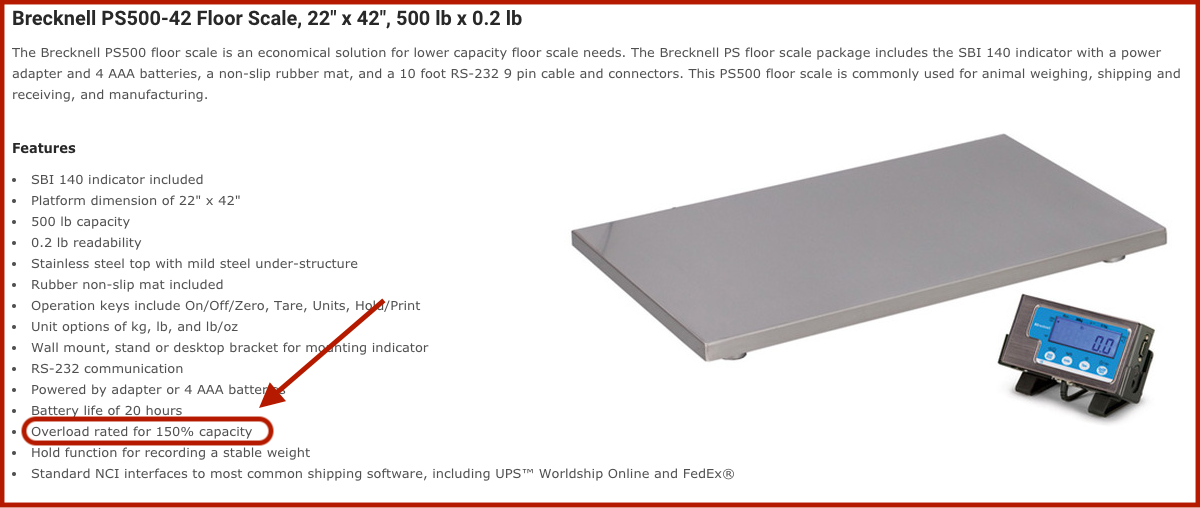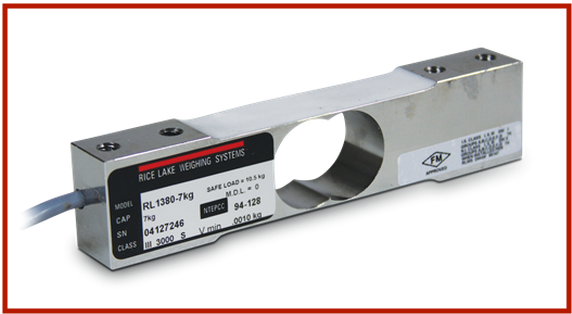What Happens to a Scale When It's Overloaded?
Posted by Greg J on May 27th 2021
While most of us know better than to drive a full-size sedan over a small bathroom scale, what many people don’t realize is just how often heavy objects get placed on a scale that exceeds its maximum capacity.
Fortunately, scale manufacturers are aware of this issue and have purposely designed their products to allow for a particular amount of overload.
What is scale overload?
As the name suggests, scale overload is a term that refers to any weighed object that exceeds a scale’s maximum capacity rating. If a scale’s maximum capacity is 500 lbs. and you place an object on it that weighs 520 lbs., you’ve overloaded that scale.
Fortunately, that 520 lb. object will probably not do any real harm to the scale because most modern manufacturers have designed their scales to handle an overload capacity of anywhere from 125-175%.
In this case, that 520 lb. object is only an overload of 104%, which is well under the 150% overload rating of the scale we’re using.
With that said, a scale will often go into an error code once the rated capacity is met. This is to notify the operator that the standard capacity has been reached and the item being weighed needs to be removed immediately.

The overload rating of a scale is almost always listed in its product manual, typically in the specifications section near the maximum capacity rating. At Scales Plus, we also include this number in the product description, so you are always aware before you buy.
How do you calculate overload?
To determine the overload of an object, simply take the weight of the object and divide it by the maximum capacity of the scale. Then multiply that number by 100 to get a percentage.
Let’s use the same example from before:
520 lbs. / 500 lbs. = 1.04
1.04 x 100 = 104% overload
To determine the maximum overload weight a scale can safely handle before being irreparably damaged, first take the overload rating percentage and divide that by 100. Then multiply that number by the maximum capacity of the scale.
Using our same scale from above, we get:
150% / 100 = 1.5
1.5 x 500 lbs. = 750 lbs.
So, this scale could—in theory—measure an object that weighs as much as 750 lbs. However, it’s most likely going to display some form of “ERROR” message, so there’s really no point in doing so.
Please note: This number is only intended as a safety net and doesn’t guarantee your scale won’t still be damaged after one or more overloads. If you plan to weigh an object that exceeds the maximum capacity, we highly recommend you use a larger scale.
What happens to a scale that’s overloaded?
Overloading your scale can cause irreparable damage to the internal load cell. A load cell is essentially a force transducer—a small, mostly metal object located within the scale that determines the weight of the object to be measured.
Learn more about load cells and how they work.

When an object is weighed that falls within the scale’s maximum capacity rating, the load cell will deform elastically and return to its previous shape once the object is removed.
With an object that exceeds the maximum capacity, the load cell may inelastically deform beyond its limits, meaning it won’t be able to return to its pre-weight shape and will no longer function as it should.
In other words, it’s not good.
Signs that a load cell is damaged
There are many ways to determine if a scale’s load cell has been mechanically damaged:
- The scale refuses to turn on
- You get an error message at startup
- Inconsistent and/or fluctuating readings
- An Overload Indicator/Weighmeter icon appears
- The reading doesn’t change when a load is applied
- The display doesn’t return to zero after a load is removed
What to do if your load cell is damaged
If you believe your scale has a damaged load cell, the first thing you can do is attempt to calibrate it. If it’s still giving you inaccurate readings, you may need to remove the load cell for a visual check.
If you notice any significant deformation, cracks, or other observable damage, your load cell may be beyond repair. At this point, you have three options:
- Send in your scale for repair
- Purchase a new load cell
- Replace the scale altogether (Occasionally, replacing a load cell can cost as much, if not more, than the cost of a new scale.)
If you decide to go the repair route, the team at Scales Plus can help. Our expert technicians can repair most of today’s brands and models, and our full-service lab is outfitted with the equipment and software necessary to repair your instruments quickly and correctly. Contact our Parts Department today.

Please note: Damaged load cells may not be eligible for warranty repairs or returns. Scale overload is considered a user error and not a manufacturer defect, meaning any damage incurred as a result of overloading WILL NOT be covered under the manufacturer’s warranty.
Of course, the best way to keep from damaging your scale is to avoid weighing items that are heavier than your scale’s maximum capacity in the first place. So, the next time you back your full-size sedan out of the garage, make sure there aren’t any bathroom scales in the way.





